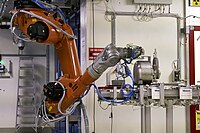
Photo from wikipedia
This article discusses both test setup and signal processing techniques to achieve highly accurate radar cross section (RCS) measurements across a wide bandwidth. This high accuracy is achieved through both… Click to show full abstract
This article discusses both test setup and signal processing techniques to achieve highly accurate radar cross section (RCS) measurements across a wide bandwidth. This high accuracy is achieved through both postprocessing algorithms and test setup hardware modifications. The postprocessing techniques include calibration, clutter cancellation, and time-gating, all of which are applicable to a generic anechoic chamber setup. Specialized RCS measurement equipment such as a vector network analyzer (VNA) capable of producing nanosecond-length pulses is not necessary. However, strategic, inexpensive hardware modifications further improve measurement quality. Experiments are conducted at the University of Oklahoma in the far-field anechoic chamber to evaluate the effects of the postprocessing and setup variations on the measurement accuracy. Parameters including object support pedestal geometry, VNA intermediate frequency (IF) bandwidth, and azimuthal angle rotation are studied. Trade-offs between time, cost, and accuracy are considered in the context of these variables. By upgrading the measurement setup hardware and applying optimized processing techniques, the RCS average error is reduced from 3.2 dBsm to only 0.21 dBsm across the 2-18-GHz frequency range. The versatility of these techniques is then demonstrated by measuring a distributed target with an average error of 0.94 dBsm from 2 to 8 GHz when compared with simulation.
Journal Title: IEEE Transactions on Instrumentation and Measurement
Year Published: 2022
Link to full text (if available)
Share on Social Media: Sign Up to like & get
recommendations!